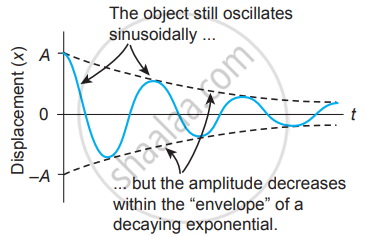Advertisements
Advertisements
Question
Explain in detail the four different types of oscillations.
Solution
(i) Free oscillations: When the oscillator is allowed to oscillate by displacing its position from the equilibrium position, it oscillates with a frequency which is equal to the natural frequency of the oscillator. Such an oscillation or vibration is known as free oscillation or free vibration. In this case, the amplitude, frequency and energy of the vibrating object remains constant.
Examples:
- Vibration of a tuning fork.
- Vibration in a stretched string.
- Oscillation of a simple pendulum.
- Oscillations of a spring-mass system.
(ii) Damped oscillations: During the oscillation of a simple pendulum (in the previous case), we have assumed that the amplitude of the oscillation is constant and also the total energy of the oscillator is constant. But in reality, in a medium, due to the presence of friction and air drag, the amplitude of oscillation decreases as time progresses. It implies that the oscillation is not sustained and the energy of the SHM decreases gradually indicating the loss of energy.
The energy lost is absorbed by the surrounding medium. This type of oscillatory motion is known as damped oscillation. In other words, if an oscillator moves in a resistive medium, its amplitude goes on decreasing and the energy of the oscillator is used to do work against the resistive medium. The motion of the oscillator is said to be damped and in this case, the resistive force (or damping force) is proportional to the velocity of the oscillator.

Damped harmonic oscillator – amplitude decreases as time increases
Examples:
- The oscillations of a pendulum (including air friction) or pendulum oscillating inside an oil-filled container.
- Electromagnetic oscillations in a tank circuit.
- Oscillations in a dead beat and ballistic galvanometers.
(iii) Maintained oscillations: While playing in swing, the oscillations will stop after a few cycles, this is due to damping. To avoid damping we have to supply a push to sustain oscillations. By supplying energy from an external source, the amplitude of the oscillation can be made constant. Such vibrations are known as maintained vibrations.
Example: The vibration of a tuning fork getting energy from a battery or from an external power supply.
(iv) Forced oscillations: Any oscillator driven by an external periodic agency to overcome the damping is known as a forced oscillator or driven oscillator. In this type of vibration, the body executing vibration initially vibrates with its natural frequency and due to the presence of external periodic force, the body later vibrates with the frequency of the applied periodic force. Such vibrations are known as forced vibrations.
Example: Sound boards of stringed instruments.
APPEARS IN
RELATED QUESTIONS
A hollow sphere is filled with water. It is hung by a long thread. As the water flows out of a hole at the bottom, the period of oscillation will ____________.
The damping force on an oscillator is directly proportional to the velocity. The units of the constant of proportionality are
When a damped harmonic oscillator completes 100 oscillations, its amplitude is reduced to `1/3` of its initial value. What will be its amplitude when it completes 200 oscillations?
Which of the following differential equations represents a damped harmonic oscillator?
What is meant by free oscillation?
Explain damped oscillation. Give an example.
Define forced oscillation. Give an example.
What is meant by maintained oscillation? Give an example.
Explain resonance. Give an example.
